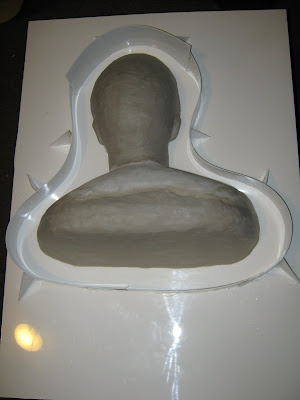
Earlier in July we were approached by Robbie, a VCA filmmaker, to do make-up, hair and special effects on his second year film. We had planned on taking a bit of a break from doing student films but Robbie had written a fantastic and unconventional horror-chick flick script that after reading and discussing the overall aesthetic we really wanted to be involved in.

After doing a cheap alginate life-cast of the back of the lead actress's head and neck we did some re-sculpting work before making a mould for a prop spfx head.

A big part of this project was making a variety of moulds for different purposes: some for props and others for making prosthetics. The following clip shows three moulds in various stages:
Nailed Darlings involved four prosthetic wound applications: one on a lead actor's face, another on her back and then applications on the other lead actress's throat and back of neck. For this project we made and used encapsulated silicone appliances and adhered with a combination of Telesis and silicone. I've come to favour silicone as an adhesive due to ease of clean up and not having to use generally harsh solvents on an actors skin for clean up. We've now pretty much got most adhesion issues sorted out and the pieces on one actor's back would have lasted for over a day's shoot without the edges coming up.

Nailed Darlings also called for quite a lot of blood work; for this we used a Mouldlife product called Kensington Venial. It looks great, doesn't dry out, doesn't stain an actor's skin and only needs water for clean up.


Nailed Darlings involved significant hair and make-up as well as prosthetics and special effects on a tight budget. When talking with independent or student filmmakers who haven't used prosthetics or practical special effects before its always a bit of a shock to them when we tell them what it costs to make something. It's also a bit tricky explaining processes, but needless to say its really easy to quickly blow hundreds of dollars on materials for making stuff. I thought we'd get the work for this film in just under the modest special make-up fx budget of $600, but we ended $180 over not counting outlay costs for things we could reuse like the wig ($40) and HIPS (~$40). However, what we learned from this film was arguably worth this.
Equally the work that's the most risky in terms of going over budget is also the most interesting and fun for us. The difficult thing tends to be estimating what something might cost which you've never made before. For feature films though the material costs will always be the smaller cost next to labour. At IMATS last year I learned that up the big end of town full facial silicone prosthetics can cost up to $20,000 before they are even applied on set! Full silicone bodies with significant resculpting can cost up to $100,000!!! Seems like a lot, but anywhere between one and six people may have worked on something like this for many hours in the studio before it makes it on set. So bigger picture and all that; I'm really proud of what we got done with what we had and hopefully it'll all make for a great short film.













































